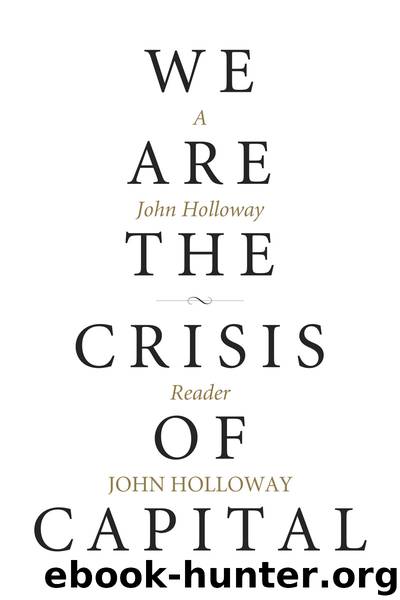We Are the Crisis of Capital by Holloway John;

Author:Holloway, John;
Language: eng
Format: epub
Publisher: PM Press
Published: 2019-03-07T16:00:00+00:00
1EZLN, La Palabra de los Armados de Verdad y Fuego, vol. 1 (Mexico City: Editorial Fuenteovejuna, 1994), 31–32. The three volumes of this series are an invaluable source of EZLN interviews, letters, and communiqués from 1994. All translations of Spanish quotations are by the author.
2EZLN, La Palabra, vol. 1, 35.
3Clandestine Revolutionary Indigenous Committee.
4The Council 500 Years of Indigenous Resistance.
5EZLN, La Palabra, vol. 1, 122; emphasis in the original. The continuing importance of this passage was underlined when it was quoted by Comandante Ramona in her speech to a meeting held in Mexico City on February 16, 1997, to protest against the government’s failure to fulfil the Agreements of San Andrés.
6Ejército Zapatista de Liberación Nacional: Zapatista Army of National Liberation.
7Subcomandante Insurgente Marcos, November 17, 1994: EZLN, La Palabra, vol. 3, 224. Marcos is the spokesperson and military leader of the EZLN. He is, however, subordinate to the CCRI, a popularly elected body. “Mestizos” are people of mixed indigenous and European origin—the vast majority of the Mexican population.
8Forces of National Liberation.
9Quoted in C. Tello Díaz, La Rebelión de las Cañadas (Mexico City: Cal y Arena, 1995), 97, 99.
10The EZLN’s reply to the government’s claim is contained in a February 9, 1995, communiqué: “In relation to the connections of the EZLN with the organisation called ‘Forces of National Liberation,’ the EZLN has declared in interviews, letters, and communiqués that members of different armed organisations of the country came together in its origin, that the EZLN was born from that and, gradually, was appropriated by the indigenous communities to the point where they took over the political and military leadership of the EZLN. To the name of the ‘Forces of National Liberation,’ the government should add as the antecedents of the EZLN those of all the guerrilla organisations of the ’70s and ’80s, Arturo Gámiz, Lucio Cabañas, Genaro Vázquez Rojas, Emiliano Zapata, Francisco Villa, Vicente Guerrero, José María Morelos y Pavón, Miguel Hidalgo y Costilla, Benito Juárez, and many others whom they have already erased from the history books, because a people with memory is a rebel people” (La Jornada, February 13, 1995).
11Subcomandante Insurgente Marcos, “Carta a Adolfo Gilly,” Viento del Sur, no.4 (Summer 1995), 21–25, at 25.
12See the account given by Tello (La Rebelión, 105) of the meeting between some of the insurgent leaders and the community of the ejido of San Francisco on September 23, 1985.
13See the account given by Marcos in an interview with Radio UNAM, March 18, 1994 (EZLN, La Palabra, vol. 2, 69). The “white guards” are paid paramilitary groups who, often in collusion with the authorities, violently suppress protest and dissent.
14Decree of the Lacandon Community, see Tello, La Rebelión, 59ff.
15Radio UNAM interview with Marcos, March 18, 1994, see EZLN, La Palabra, vol. 2, 69–70.
16Marcos, Letter to children of a boarding school in Guadalajara, February 8, 1994, see EZLN, La Palabra, vol. 1, 179.
17Radio UNAM interview with Marcos, March 18, 1994, EZLN, see La Palabra, vol. 2, 62.
18Marcos interview with Cristián Calónico Lucio, November 11, 1995, ms, 47. The interview is unpublished in written form but formed the basis of a video.
Download
This site does not store any files on its server. We only index and link to content provided by other sites. Please contact the content providers to delete copyright contents if any and email us, we'll remove relevant links or contents immediately.
| Anarchism | Communism & Socialism |
| Conservatism & Liberalism | Democracy |
| Fascism | Libertarianism |
| Nationalism | Radicalism |
| Utopian |
The Secret History by Donna Tartt(18840)
The Social Justice Warrior Handbook by Lisa De Pasquale(12141)
Thirteen Reasons Why by Jay Asher(8791)
This Is How You Lose Her by Junot Diaz(6780)
Weapons of Math Destruction by Cathy O'Neil(6141)
Zero to One by Peter Thiel(5684)
Beartown by Fredrik Backman(5594)
The Myth of the Strong Leader by Archie Brown(5422)
The Fire Next Time by James Baldwin(5247)
How Democracies Die by Steven Levitsky & Daniel Ziblatt(5127)
Promise Me, Dad by Joe Biden(5087)
Stone's Rules by Roger Stone(5026)
A Higher Loyalty: Truth, Lies, and Leadership by James Comey(4842)
100 Deadly Skills by Clint Emerson(4840)
Rise and Kill First by Ronen Bergman(4701)
Secrecy World by Jake Bernstein(4642)
The David Icke Guide to the Global Conspiracy (and how to end it) by David Icke(4624)
The Farm by Tom Rob Smith(4434)
The Doomsday Machine by Daniel Ellsberg(4415)
